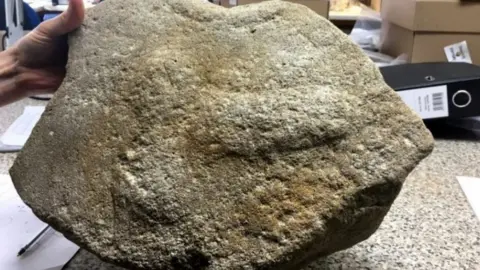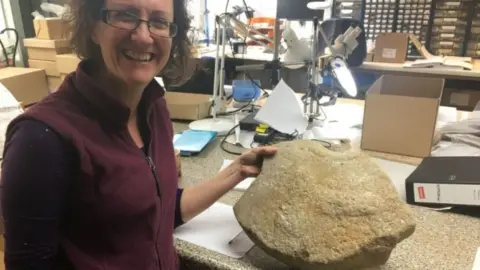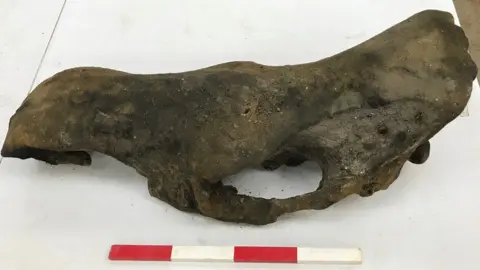A14 upgrade: 'Rare' Roman penis carving found in Cambridgeshire
 Highways England
Highways EnglandA "highly significant" and rare carved Roman phallus has been discovered by archaeologists working on finds unearthed during a major road upgrade.
It was found on a broken millstone by experts along the route of the A14 in Cambridgeshire between 2017 and 2018.
However, it has only just been put back together, revealing the penis.
Archaeologists said it was one of only four known examples of Romano-British millstones decorated this way.
During work on Highways England's £1.5bn upgrade of the A14 between Cambridge and Huntingdon, more than 300 querns (hand mills) and millstones were recovered by archaeologists MOLA Headland Infrastructure, working with partners Oxford Archaeology.
The stone which recently revealed its genital markings had been preserved by being reversed and adapted for use as a bedstone, after being initially broken.
Decorated querns and millstones of any date are extremely rare, with only four such Roman millstones discovered from around a total of 20,000 nationwide, said Steve Sherlock, Highways England's archaeology lead for the A14.
He said phallic images were "seen as an important image of strength and virility in the Roman world, with it being common practice for legionaries to wear a phallus amulet, which would give them good luck before battle".
 Highways England
Highways England"This millstone is important as it adds to the evidence for such images from Roman Britain.
"There were known associations between images of the phallus and milling, such as those found above the bakeries of Pompeii, one inscribed with 'Hic habitat felicitas' - 'You will find happiness here'," he said.
Dr Ruth Shaffrey, from Oxford Archaeology, said: "As one of only four known examples of Romano-British millstones decorated this way, the A14 millstone is a highly significant find.
"It offers insights into the importance of the mill to the local community and to the protective properties bestowed upon the millstone and its produce - the flour - by the depiction of a phallus on its upper surface.
"In the Roman world the phallic image was found all over the place. It was associated with good luck."
The millstone is the latest in a list of finds on the route of the upgrade to be made public by Highways England.

They include the earliest evidence of beer brewing in Britain, dating back to as early as 400 BC, only the second gold coin to be found in the country depicting Roman emperor Laelianus, who reigned for about two months in 269 AD before he was killed, and woolly mammoth tusks and woolly rhino skulls.

Find BBC News: East of England on Facebook, Instagram and Twitter. If you have a story suggestion email eastofenglandnews@bbc.co.uk